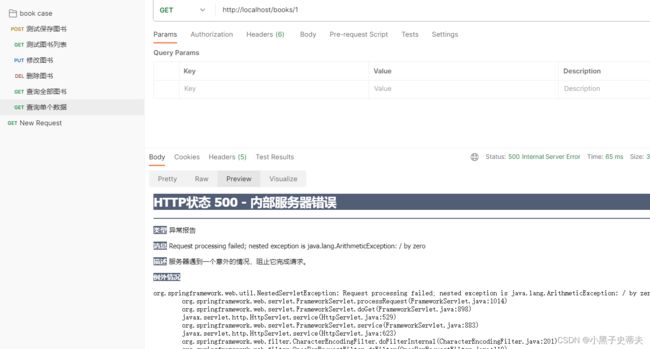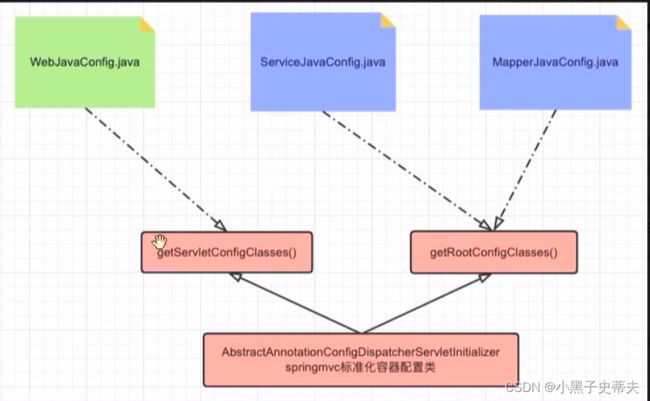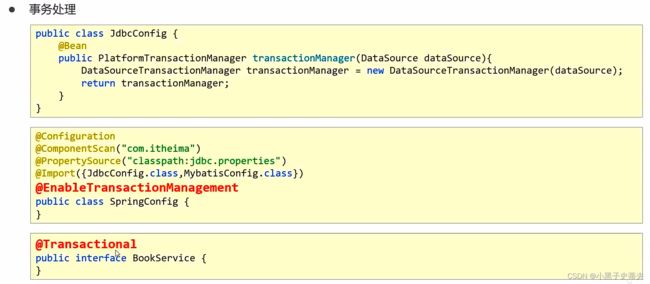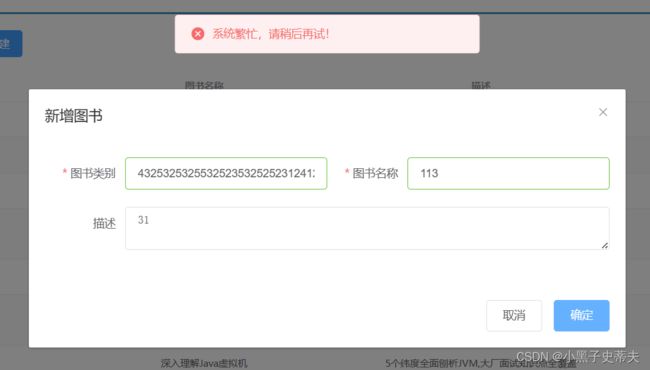小黑子的SSM整合
SSM整合
- 一、基于restful页面数据交互
-
- 1.1 后台接口开发
- 1.2 页面访问处理
- 二、ssm整合
-
- 2.1 流程分析
- 2.2 整合配置
- 2.3 功能模块开发
- 2.4 接口测试
- 2.5 表现层与前端数据传输协议定义
-
- 2.5.1 协议实现
- 2.6 异常处理器
-
- 2.6.1 @RestControllerAdvice
- 2.6.2 @ExceptionHandler
- 2.6.3 项目异常处理
-
- 2.6.3-I 异常分类
- 2.6.3-II 异常解决方案
- 2.6.3-III 具体实现
- 2.7 前后台协议联调
-
- 2.7.1 列表功能
- 2.7.2 添加功能
-
- 2.7.3 添加功能状态处理
- 2.7.4 修改功能
- 2.7.5 删除功能
一、基于restful页面数据交互
1.1 后台接口开发
准备:
-
pom文件的导包
<dependencies> <dependency> <groupId>org.springframeworkgroupId> <artifactId>spring-contextartifactId> <version>5.3.7 version> dependency> <dependency> <groupId>junitgroupId> <artifactId>junitartifactId> <version>4.13.2version> <scope>testscope> dependency> <dependency> <groupId>org.springframeworkgroupId> <artifactId>spring-webartifactId> <version>5.3.7version> dependency> <dependency> <groupId>org.springframeworkgroupId> <artifactId>spring-webmvcartifactId> <version>5.3.7version> dependency> <dependency> <groupId>com.alibabagroupId> <artifactId>druidartifactId> <version>1.1.23version> dependency> <dependency> <groupId>mysqlgroupId> <artifactId>mysql-connector-javaartifactId> <version>8.0.30version> dependency> <dependency> <groupId>org.mybatisgroupId> <artifactId>mybatisartifactId> <version>3.5.5version> dependency> <dependency> <groupId>javax.servletgroupId> <artifactId>javax.servlet-apiartifactId> <version>4.0.1version> <scope>providedscope> dependency> <dependency> <groupId>org.mybatisgroupId> <artifactId>mybatis-springartifactId> <version>3.0.1version> dependency> <dependency> <groupId>org.springframeworkgroupId> <artifactId>spring-jdbcartifactId> <version>5.2.25.RELEASEversion> dependency> <dependency> <groupId>javax.annotationgroupId> <artifactId>jsr250-apiartifactId> <version>1.0version> dependency> <dependency> <groupId>org.aspectjgroupId> <artifactId>aspectjweaverartifactId> <version>1.9.6version> dependency> <dependency> <groupId>org.springframeworkgroupId> <artifactId>spring-testartifactId> <version>5.0.9.RELEASEversion> <scope>testscope> dependency> <dependency> <groupId>com.fasterxml.jackson.coregroupId> <artifactId>jackson-databindartifactId> <version>2.9.0version> dependency> dependencies> -
config包下的固定配置类
//web容器的配置类 public class ServletContainersInitConfig extends AbstractAnnotationConfigDispatcherServletInitializer { protected Class<?>[] getRootConfigClasses() { return new Class[0]; } protected Class<?>[] getServletConfigClasses() { return new Class[]{SpringMvcConfig.class}; } protected String[] getServletMappings() { return new String[]{"/"}; } //乱码处理 @Override protected Filter[] getServletFilters(){ CharacterEncodingFilter filter = new CharacterEncodingFilter(); filter.setEncoding("UTF-8"); return new Filter[]{filter}; } }@Configuration @ComponentScan("com.itheima.controller") @EnableWebMvc public class SpringMvcConfig { } -
controller包
@RestController @RequestMapping("/books") public class BookController { @PostMapping public String save(@RequestBody Book book){//接收json数据格式 System.out.println("book save ==>"+book); return "{'module':'book save success'}"; } @GetMapping public List<Book> getAll(){ List<Book> bookList = new ArrayList<Book>(); Book book1 = new Book(); book1.setType("计算机"); book1.setName("SpringMVC入门"); book1.setDescription("小试牛刀"); bookList.add(book1); Book book2 = new Book(); book2.setType("计算机"); book2.setName("SpringMVC实战教程"); book2.setDescription("一代宗师"); bookList.add(book2); return bookList; } } -
pojo实体类
public class Book { private Integer id; private String type; private String name; private String description; @Override public String toString() { return "Book{" + "id=" + id + ", type='" + type + '\'' + ", name='" + name + '\'' + ", description='" + description + '\'' + '}'; } public Book() { } public Book(Integer id, String type, String name, String description) { this.id = id; this.type = type; this.name = name; this.description = description; } public Integer getId() { return id; } public void setId(Integer id) { this.id = id; } public String getType() { return type; } public void setType(String type) { this.type = type; } public String getName() { return name; } public void setName(String name) { this.name = name; } public String getDescription() { return description; } public void setDescription(String description) { this.description = description; } }
1.2 页面访问处理
- 修改扫描包部分
@Configuration
@ComponentScan({"com.itheima.controller","com.itheima.config"})
@EnableWebMvc
public class SpringMvcConfig {
}
- config包的SpringMvcSupport
@Configuration
public class SpringMvcSupport extends WebMvcConfigurationSupport {
//设置静态资源访问过滤,当前类需要设置为配置类,并被扫描加载
@Override
protected void addResourceHandlers(ResourceHandlerRegistry registry) {
//当访问/pags/????时候,走page目录下的内容
registry.addResourceHandler("/pages/**").addResourceLocations("/pages/");
registry.addResourceHandler("/js/**").addResourceLocations("/js/");
registry.addResourceHandler("/css/**").addResourceLocations("/css/");
registry.addResourceHandler("/plugins/**").addResourceLocations("/plugins/");
}
}
DOCTYPE html>
<html>
<head>
<meta charset="utf-8">
<title>SpringMVC案例title>
<link rel="stylesheet" href="../plugins/elementui/index.css">
<link rel="stylesheet" href="../plugins/font-awesome/css/font-awesome.min.css">
<link rel="stylesheet" href="../css/style.css">
head>
<body class="hold-transition">
<div id="app">
<div class="content-header">
<h1>图书管理h1>
div>
<div class="app-container">
<div class="box">
<div class="filter-container">
<el-input placeholder="图书名称" style="width: 200px;" class="filter-item">el-input>
<el-button class="dalfBut">查询el-button>
<el-button type="primary" class="butT" @click="openSave()">新建el-button>
div>
<el-table size="small" current-row-key="id" :data="dataList" stripe highlight-current-row>
<el-table-column type="index" align="center" label="序号">el-table-column>
<el-table-column prop="type" label="图书类别" align="center">el-table-column>
<el-table-column prop="name" label="图书名称" align="center">el-table-column>
<el-table-column prop="description" label="描述" align="center">el-table-column>
<el-table-column label="操作" align="center">
<template slot-scope="scope">
<el-button type="primary" size="mini">编辑el-button>
<el-button size="mini" type="danger">删除el-button>
template>
el-table-column>
el-table>
<div class="pagination-container">
<el-pagination
class="pagiantion"
@current-change="handleCurrentChange"
:current-page="pagination.currentPage"
:page-size="pagination.pageSize"
layout="total, prev, pager, next, jumper"
:total="pagination.total">
el-pagination>
div>
<div class="add-form">
<el-dialog title="新增图书" :visible.sync="dialogFormVisible">
<el-form ref="dataAddForm" :model="formData" :rules="rules" label-position="right" label-width="100px">
<el-row>
<el-col :span="12">
<el-form-item label="图书类别" prop="type">
<el-input v-model="formData.type"/>
el-form-item>
el-col>
<el-col :span="12">
<el-form-item label="图书名称" prop="name">
<el-input v-model="formData.name"/>
el-form-item>
el-col>
el-row>
<el-row>
<el-col :span="24">
<el-form-item label="描述">
<el-input v-model="formData.description" type="textarea">el-input>
el-form-item>
el-col>
el-row>
el-form>
<div slot="footer" class="dialog-footer">
<el-button @click="dialogFormVisible = false">取消el-button>
<el-button type="primary" @click="saveBook()">确定el-button>
div>
el-dialog>
div>
div>
div>
div>
body>
<script src="../js/vue.js">script>
<script src="../plugins/elementui/index.js">script>
<script type="text/javascript" src="../js/jquery.min.js">script>
<script src="../js/axios-0.18.0.js">script>
<script>
var vue = new Vue({
el: '#app',
data:{
dataList: [],//当前页要展示的分页列表数据
formData: {},//表单数据
dialogFormVisible: false,//增加表单是否可见
dialogFormVisible4Edit:false,//编辑表单是否可见
pagination: {},//分页模型数据,暂时弃用
},
//钩子函数,VUE对象初始化完成后自动执行
created() {
this.getAll();
},
methods: {
// 重置表单
resetForm() {
//清空输入框
this.formData = {};
},
// 弹出添加窗口
openSave() {
this.dialogFormVisible = true;
this.resetForm();
},
//添加
saveBook () {
axios.post("/books",this.formData).then((res)=>{
});
},
//主页列表查询
getAll() {
axios.get("/books").then((res)=>{
this.dataList = res.data;
});
},
}
})
script>
html>
二、ssm整合
什么是ssm整合?
- 微观:将学习的Spring SpringMVC Mybatis框架应用到项目中!
- SpringMVC框架负责控制层
- Spring框架负责整体和业务层的声明式事务管理
- MyBatis框架负责数据库访问层
- 宏观:Spring 接管一切(将框架核心组件交给Spring进行loC管理)。代码更加简洁。
- SpringMVC管理表述层、SpringMVC相关组件
- Spring 管理业务层、持久层、以及数据库相关(DataSource,MyBatis)的组件
- 使用loC的方式管理一切所需组件
- 实施:通过编写配置文件,实现 SpringloC容器接管—切组件。
思考:
第一问: ssm整合需要几个IoC容器?
两个容器
本质上说,整合就是将三层架构和框架核心API组件交给SpringloC容器管理!一个容器可能就够了,但是我们常见的操作是创建两个loC容器(web容器和root容器),组件分类管理! 这种做法有以下好处和目的:
- 分离关注点:通过初始化两个容器,可以将各个层次的关注点进行分离。这种分离使得各个层次的组件能够更好地聚焦于各自的责任和功能。
- 解耦合:各个层次组件分离装配不同的loC容器,这样可以进行解耦。这种解耦合使得各个模块可以独立操作和测试,提高了代码的可维护性和可测试性。
- 灵活配置:通过使用两个容器,可以为每个容器提供各自的配置,以满足不同层次和组件的特定需求。每个配置文件也更加清晰和灵活。
总的来说,初始化两个容器在SSM整合中可以实现关注点分离、解耦合、灵活配置等好处。它们各自负责不同的层次和功能,并通过合适的集成方式协同工作,提供一个高效、可维护和可扩展的应用程序架构!
| 容器名 | 盛放组件 |
|---|---|
| web容器 | web相关组件(controller,springmvc核心组件) |
| root容器 | 业务和持久层相关组件(service,aop,tx,dataSource,mybatis,mapper等) |
第三问:IoC容器之间关系和调用方向
结论:web容器是root容器的子容器,父子容器关系
- 父容器:root容器,放service、mapper、mybatis等
- 子容器:web容器,放controller、web相关等
第四问: 具体多少配置类以及对应容器关系
配置类的数量是不固定的,但是至少要两个,为了方便编写,可以三层架构每层对应一个配置类,分别指定两个容器加载即可
建议的相关配置文件:
| 配置名 | 对应内容 | 对应容器 |
|---|---|---|
| WebJavaConfig | controller,springMvc相关 | web容器 |
| ServiceJavaConfig | service,aop,tx相关 | root容器 |
| MapperJavaConfig | mapper,datasource,mybatis相关 | root容器 |
第五问:IoC初始化方式和配置关系
在web项目下,可以选择web.xml和配置类方式进行ioc配置,推荐配置类。
对于使用基于web的Spring配置的应用程序,建议如下的示例:
图解配置类和容器配置:
2.1 流程分析
-
创建工程
- 创建一个Maven的web工程
- pom.xml添加SSM需要的依赖jar包
- 编写Web项目的入口配置类,实现
AbstractAnnotationConfigDispatcherServletInitializer重写以下方法getRootConfigClasses():返回Spring的配置类 --> 需要SpringConfig配置类getServletConfigClasses():返回SpringMVC的配置类 --> 需要SpringMvcConfig配置类getServletMappings(): 设置SpringMVC请求拦截路径规则getServletFilters():设置过滤器,解决POST请求中文乱码问题
-
SSM整合(重点是各个配置的编写)
- SpringConfig
- 标识该类为配置类,使用
@Configuration - 扫描Service所在的包,使用
@ComponentScan - 在
Service层要管理事务,使用@EnableTransactionManagement - 读取外部的
properties配置文件,使用@PropertySource - 整合
Mybatis需要引入Mybatis相关配置类,使用@Import- 第三方数据源配置类 JdbcConfig
- 构建DataSource数据源,DruidDataSouroce,需要注入数据库连接四要素,使用
@Bean、@Value - 构建平台事务管理器,
DataSourceTransactionManager,使用@Bean - Mybatis配置类
MybatisConfig - 构建
SqlSessionFactoryBean并设置别名扫描与数据源,使用@Bean - 构建
MapperScannerConfigurer并设置DAO层的包扫描
- 标识该类为配置类,使用
- SpringMvcConfig
- 标识该类为配置类,使用
@Configuratio - 扫描
Controller所在的包,使用@ComponentScan - 开启SpringMVC注解支持,使用
@EnableWebMvc
- 标识该类为配置类,使用
- SpringConfig
-
功能模块(与具体的业务模块有关)
- 创建数据库表
- 根据数据库表创建对应的模型类
- 通过Dao层完成数据库表的增删改查(接口+自动代理)
- 编写Service层(Service接口+实现类)
@Service@Transactional- 整合Junit对业务层进行单元测试
@RunWith@ContextConfiguration@Test
- 编写
Controller层- 接收请求
@RequestMapping、@GetMapping、@PostMapping、@PutMapping、@DeleteMapping - 接收数据 简单、POJO、嵌套POJO、集合、数组、JSON数据类型
- @RequestParam
- @PathVariable
- @RequestBody
- 转发业务层
@Autowired
- 响应结果
@ResponseBody
- 接收请求
2.2 整合配置
-
步骤一:创建Maven的web项目
-
步骤二:导入坐标
<dependencies> <dependency> <groupId>org.springframeworkgroupId> <artifactId>spring-webmvcartifactId> <version>5.2.10.RELEASEversion> dependency> <dependency> <groupId>org.springframeworkgroupId> <artifactId>spring-jdbcartifactId> <version>5.2.10.RELEASEversion> dependency> <dependency> <groupId>org.springframeworkgroupId> <artifactId>spring-testartifactId> <version>5.2.10.RELEASEversion> dependency> <dependency> <groupId>org.mybatisgroupId> <artifactId>mybatisartifactId> <version>3.5.6version> dependency> <dependency> <groupId>org.mybatisgroupId> <artifactId>mybatis-springartifactId> <version>1.3.0version> dependency> <dependency> <groupId>mysqlgroupId> <artifactId>mysql-connector-javaartifactId> <version>5.1.46version> dependency> <dependency> <groupId>com.alibabagroupId> <artifactId>druidartifactId> <version>1.1.16version> dependency> <dependency> <groupId>junitgroupId> <artifactId>junitartifactId> <version>4.12version> <scope>testscope> dependency> <dependency> <groupId>javax.servletgroupId> <artifactId>javax.servlet-apiartifactId> <version>3.1.0version> <scope>providedscope> dependency> <dependency> <groupId>com.fasterxml.jackson.coregroupId> <artifactId>jackson-databindartifactId> <version>2.9.0version> dependency> dependencies> -
步骤三:创建项目包结构
- com.blog.config目录存放的是相关的配置类
- com.blog.controller编写的是Controller类
- com.blog.dao存放的是Dao接口,因为使用的是Mapper接口代理方式,所以没有实现类包
- com.blog.service存的是Service接口,com.blog.service.impl存放的是Service实现类
- resources:存入的是配置文件,如Jdbc.properties
- webapp:目录可以存放静态资源
- test/java:存放的是测试类
-
步骤四:创建jdbc.properties
jdbc.driver=com.mysql.jdbc.Driver jdbc.url = jdbc:mysql://localhost:3306/ssm_db?useSSL=false jdbc.username=root jdbc.password=root. -
步骤五:创建JdbcConfig配置类
public class JdbcConfig { @Value("${jdbc.driver}") private String driver; @Value("${jdbc.url}") private String url; @Value("${jdbc.username}") private String username; @Value("${jdbc.password}") private String password; @Bean public DataSource dataSource() { DruidDataSource dataSource = new DruidDataSource(); dataSource.setDriverClassName(driver); dataSource.setUrl(url); dataSource.setUsername(username); dataSource.setPassword(password); return dataSource; } @Bean public PlatformTransactionManager platformTransactionManager(DataSource dataSource){ DataSourceTransactionManager ds = new DataSourceTransactionManager(); ds.setDataSource(dataSource); return ds; } } -
步骤六:创建MyBatisConfig配置类
public class MyBatisConfig { @Bean public SqlSessionFactoryBean sqlSessionFactory(DataSource dataSource){ SqlSessionFactoryBean factoryBean = new SqlSessionFactoryBean(); factoryBean.setDataSource(dataSource); factoryBean.setTypeAliasesPackage("com.blog.domain"); return factoryBean; } @Bean public MapperScannerConfigurer mapperScannerConfigurer(){ MapperScannerConfigurer msc = new MapperScannerConfigurer(); msc.setBasePackage("com.blog.dao"); return msc; } } -
步骤七:创建SpringConfig配置类
@Configuration @ComponentScan("com.blog.service") @PropertySource("jdbc.properties") @EnableTransactionManagement @Import({JdbcConfig.class, MyBatisConfig.class}) public class SpringConfig { } -
步骤八:创建SpringMvcConfig配置类
@Configuration @ComponentScan("com.blog.controller") @EnableWebMvc public class SpringMvcConfig { } -
步骤九:创建ServletContainersInitConfig配置类
public class ServletContainersInitConfig extends AbstractAnnotationConfigDispatcherServletInitializer { protected Class<?>[] getRootConfigClasses() { return new Class[]{SpringConfig.class}; } protected Class<?>[] getServletConfigClasses() { return new Class[]{SpringMvcConfig.class}; } protected String[] getServletMappings() { return new String[]{"/"}; } @Override protected Filter[] getServletFilters() { CharacterEncodingFilter filter = new CharacterEncodingFilter(); filter.setEncoding("utf-8"); return new Filter[]{filter}; } }
2.3 功能模块开发
-
步骤二:编写pojo模型类
public class Book { private Integer id; private String type; private String name; private String description; public Integer getId() { return id; } public void setId(Integer id) { this.id = id; } public String getType() { return type; } public void setType(String type) { this.type = type; } public String getName() { return name; } public void setName(String name) { this.name = name; } public String getDescription() { return description; } public void setDescription(String description) { this.description = description; } @Override public String toString() { return "Book{" + "id=" + id + ", type='" + type + '\'' + ", name='" + name + '\'' + ", description='" + description + '\'' + '}'; } } -
步骤三:编写Dao接口
public interface BookDao { @Insert("insert into tbl_book values (null, #{type}, #{name}, #{description})") void save(Book book); @Update("update tbl_book set type=#{type}, `name`=#{name}, `description`=#{description} where id=#{id}") void update(Book book); @Delete("delete from tbl_book where id=#{id}") void delete(Integer id); @Select("select * from tbl_book where id=#{id}") void getById(Integer id); @Select("select * from tbl_book") void getAll(); }
idea在进行ssm整合的过程中,如果这个东西在整个系统中目前不存在(即:spring中没有配不可dao的bean)

-
步骤四:编写Service接口及其实现类
@Transactional public interface BookService { /** * 保存 * @param book * @return */ boolean save(Book book); /** * 修改 * @param book * @return */ boolean update(Book book); /** * 按id删除 * @param id * @return */ boolean delete(Integer id); /** * 按id查询 * @param id * @return */ Book getById(Integer id); /** * 查询所有 * @return */ List<Book> getAll(); }@Service public class BookServiceImpl implements BookService { @Autowired private BookDao bookDao; public boolean save(Book book) { bookDao.save(book); return true; } public boolean update(Book book) { bookDao.update(book); return true; } public boolean delete(Integer id) { bookDao.delete(id); return true; } public Book getById(Integer id) { return bookDao.getById(id); } public List<Book> getAll() { return bookDao.getAll(); } } -
步骤五:编写Controller类
@RestController @RequestMapping("/books") public class BookController { @Autowired private BookService bookService; @PostMapping public boolean save(@RequestBody Book book) { return bookService.save(book); } @PutMapping public boolean update(@RequestBody Book book) { return bookService.update(book); } @DeleteMapping("/{id}") public boolean delete(@PathVariable Integer id) { return bookService.delete(id); } @GetMapping("/{id}") public Book getById(@PathVariable Integer id) { return bookService.getById(id); } @GetMapping public List<Book> getAll() { return bookService.getAll(); } }
2.4 接口测试
-
步骤一:新建测试类
@RunWith(SpringJUnit4ClassRunner.class) @ContextConfiguration(classes = SpringConfig.class) public class BookServiceTest { } -
步骤二:注入Service
@RunWith(SpringJUnit4ClassRunner.class) @ContextConfiguration(classes = SpringConfig.class) public class BookServiceTest { @Autowired private BookService bookService; } -
步骤三:编写测试方法
@RunWith(SpringJUnit4ClassRunner.class) @ContextConfiguration(classes = SpringConfig.class) public class BookServiceTest { @Autowired private BookService bookService; @Test public void testGetById() { Book book = bookService.getById(1); System.out.println(book); } @Test public void testGetAll() { for (Book book : bookService.getAll()) { System.out.println(book); } } }
运行报错:com.mysql.cj.jdbc.Driver
jdbc.driver = com.mysql.cj.jdbc.Driver
jdbc.url = jdbc:mysql://localhost:3306/spring_db?useSSL=false
jdbc.username = root
jdbc.password = root
修改如下:
jdbc.driver=com.mysql.jdbc.Driver
运行测试方法,可以查询到对应的数据
PostMan测试
2.5 表现层与前端数据传输协议定义
SSM整合以及功能模块开发完成后,接下来我们在上述案例的基础上,分析一下有哪些问题需要我们解决。
首先第一个问题是:
- 在Controller层增删改操作完成后,返回给前端的是boolean类型的数据
true - 在Controller层查询单个,返回给前端的是对象
-
目前我们就已经有
三种数据类型返回给前端了,随着业务的增长,我们需要返回的数据类型就会越来越多。那么前端开发人员在解析数据的时候就比较凌乱了,所以对于前端来说,如果后端能返回一个统一的数据结果,前端在解析的时候就可以按照一种方式进行解析,开发就会变得更加简单 -
所以现在我们需要解决的问题就是
如何将返回的结果数据进行统一,具体如何来做,大体思路如下
2.5.1 协议实现
对于结果封装,我们应该是在表现层进行处理,所以我们把结果类放在controller包下,当然你也可以放在domain包,这个都是可以的,具体如何实现结果封装,具体的步骤如下:
-
步骤一:创建Result类
public class Result { //描述统一格式中的编码,用于区分操作,可以简化配置0或1表示成功失败 private Integer code; //描述统一格式中的数据 private Object data; //描述统一格式中的消息,可选属性 private String msg; public Result() { } //构造器可以根据自己的需要来编写 public Result(Integer code, Object data) { this.code = code; this.data = data; } public Result(Integer code, Object data, String msg) { this.code = code; this.data = data; this.msg = msg; } public Integer getCode() { return code; } public void setCode(Integer code) { this.code = code; } public Object getData() { return data; } public void setData(Object data) { this.data = data; } public String getMsg() { return msg; } public void setMsg(String msg) { this.msg = msg; } @Override public String toString() { return "Result{" + "code=" + code + ", data=" + data + ", msg='" + msg + '\'' + '}'; } } -
步骤二:定义返回码Code类
public class Code { public static final Integer SAVE_OK = 20011; public static final Integer UPDATE_OK = 20021; public static final Integer DELETE_OK = 20031; public static final Integer GET_OK = 20041; public static final Integer SAVE_ERR = 20010; public static final Integer UPDATE_ERR = 20020; public static final Integer DELETE_ERR = 20030; public static final Integer GET_ERR = 20040; }
注意:code类中的常量设计也不是固定的,可以根据需要自行增减,例如将查询再进行细分为GET_OK,GET_ALL_OK,GET_PAGE_OK等。
-
步骤三:修改Controller类的返回值
@RestController @RequestMapping("/books") public class BookController { @Autowired private BookService bookService; @PostMapping public Result save(@RequestBody Book book) { boolean flag = bookService.save(book); return new Result(flag ? Code.SAVE_OK : Code.SAVE_ERR, flag); } @PutMapping public Result update(@RequestBody Book book) { boolean flag = bookService.update(book); return new Result(flag ? Code.UPDATE_OK : Code.UPDATE_ERR, flag); } @DeleteMapping("/{id}") public Result delete(@PathVariable Integer id) { boolean flag = bookService.delete(id); return new Result(flag ? Code.DELETE_OK : Code.DELETE_ERR, flag); } @GetMapping("/{id}") public Result getById(@PathVariable Integer id) { Book book = bookService.getById(id); Integer code = book == null ? Code.GET_ERR : Code.GET_OK; String msg = book == null ? "数据查询失败,请重试!" : ""; return new Result(code, book, msg); } @GetMapping public Result getAll() { List<Book> bookList = bookService.getAll(); Integer code = bookList == null ? Code.GET_ERR : Code.GET_OK; String msg = bookList == null ? "数据查询失败,请重试!" : ""; return new Result(code, bookList, msg); } }
2.6 异常处理器
问题描述:
在学习这部分知识之前,先来演示一个效果,修改BookController的getById()方法,手写一个异常
@GetMapping("/{id}")
public Result getById(@PathVariable Integer id) {
//当id为1的时候,手动添加了一个错误信息
if (id == 1){
int a = 1 / 0;
}
Book book = bookService.getById(id);
Integer code = book == null ? Code.GET_ERR : Code.GET_OK;
String msg = book == null ? "数据查询失败,请重试!" : "";
return new Result(code, book, msg);
}
重新启动服务器,使用PostMan发送请求,当传入的id为1时,会出现如下效果

前端接收到这个信息后,和我们之前约定的格式不一致,怎么解决呢?
在解决问题之前,我们先来看一下异常的种类,以及出现异常的原因:
- 框架内部抛出的异常:因
使用不合规导致 - 数据层抛出的异常:因使用
外部服务器故障导致(例如:服务器访问超时) - 业务层抛出的异常:因
业务逻辑书写错误导致(例如:遍历业务书写操作,导致索引越界异常等) - 表现层抛出的异常:因
数据收集、校验等规则导致(例如:不匹配的数据类型间转换导致异常) - 工具类抛出的异常:因工具类
书写不严谨,健壮性不足导致(例如:必要时放的连接,长时间未释放等)
了解完上面这些出现异常的位置,我们发现,在我们开发的任何一个位置都可能会出现异常,而且这些异常是不能避免的,所以我们就需要对这些异常来进行处理。
思考
- 各个层级均出现异常,那么异常处理代码要写在哪一层?
- 所有的异常均抛出到表现层进行处理
- 异常的种类很多,表现层如何将所有的异常都处理到呢?
- 异常分类
- 表现层处理异常,每个方法中单独书写,代码书写两巨大,且意义不强,如何解决呢?
- AOP
对于上面这些问题以及解决方案,SpringMVC已经为我们提供了一套了:
-
异常处理器:
- 集中的、统一的处理项目中出现的异常
@RestControllerAdvice public class ProjectExceptionAdvice { @ExceptionHandler(Exception.class) public Result doException(Exception ex) { return new Result(666, null); } }
2.6.1 @RestControllerAdvice
说明:此注解自带@ResponseBody注解与@Component注解,具备对应的功能
| 名称 | @RestControllerAdvice |
|---|---|
| 类型 | 类注解 |
| 位置 | Rest风格开发的控制器增强类定义上方 |
| 作用 | 为Rest风格开发的控制器类做增强 |
2.6.2 @ExceptionHandler
说明:此类方法可以根据处理的异常不同,制作多个方法分别处理对应的异常
| 名称 | @ExceptionHandler |
|---|---|
| 类型 | 方法注解 |
| 位置 | 专用于异常处理的控制器方法上方 |
| 作用 | 设置指定异常的处理方案,功能等同于控制器方法,出现异常后终止原始控制器执行,并转入当前方法执行 |
异常处理器的使用
-
步骤一:创建异常处理器类
注意:要确保SpringMvcConfig能够扫描到异常处理器类@RestControllerAdvice public class ProjectExceptionAdvice { @ExceptionHandler(Exception.class) public void doException(Exception ex) { System.out.println("嘿嘿,逮到一个异常~"); } } -
步骤二:让程序抛出异常
@GetMapping("/{id}") public Result getById(@PathVariable Integer id) { //当id为1的时候,手动添加了一个错误信息 if (id == 1){ int a = 1 / 0; } Book book = bookService.getById(id); Integer code = book == null ? Code.GET_ERR : Code.GET_OK; String msg = book == null ? "数据查询失败,请重试!" : ""; return new Result(code, book, msg); } -
步骤三:使用PostMan发送GET请求访问localhost:8080/books/1
控制台输出如下,说明异常已经被拦截,且执行了doException()方法
但是现在没有返回数据给前端,为了统一返回结果,我们继续修改异常处理器类

@RestControllerAdvice public class ProjectExceptionAdvice { @ExceptionHandler(Exception.class) public Result doException(Exception ex) { System.out.println("嘿嘿,逮到一个异常~"); return new Result(666, null, "嘿嘿,逮到一个异常~"); } }
2.6.3 项目异常处理
2.6.3-I 异常分类
因为异常的种类有很多,如果每一个异常都对应一个@ExceptionHandler,那得写多少个方法来处理各自的异常,所以我们在处理异常之前,需要对异常进行一个分类:
-
业务异常(BusinessException)
- 规范的用户行为产生的异常
- 用户在页面输入内容的时候未按照指定格式进行数据填写,如在年龄框输入的是字符串
- 规范的用户行为产生的异常
-
不规范的用户行为操作产生的异常
-
系统异常(SystemException)
-
其他异常(Exception)
将异常分类以后,针对不同类型的异常,要提供具体的解决方案
2.6.3-II 异常解决方案
业务异常(BusinessException)- 发送对应消息传递给用户,提醒规范操作
- 大家常见的就是提示用户名已存在或密码格式不正确等
- 发送对应消息传递给用户,提醒规范操作
系统异常(SystemException)- 发送固定消息传递给用户,安抚用户
- 系统繁忙,请稍后再试
- 系统正在维护升级,请稍后再试
- 系统出问题,请联系系统管理员等
- 发送特定消息给运维人员,提醒维护
- 可以发送短信、邮箱或者是公司内部通信软件
- 发送固定消息传递给用户,安抚用户
记录日志- 发消息给运维和记录日志对用户来说是不可见的,属于后台程序
其他异常(Exception)- 发送固定消息传递给用户,安抚用户
- 发送特定消息给编程人员,提醒维护(纳入预期范围内)
- 一般是程序没有考虑全,比如未做非空校验等
- 记录日志
2.6.3-III 具体实现
思路:
- 先通过自定义异常,完成2.
BusinessException和SystemException的定义- 将其他异常包装成自定义异常类型
- 在异常处理器类中对不同的异常进行处理
-
步骤一:自定义异常类
public class SystemException extends RuntimeException { private Integer code; public Integer getCode() { return code; } public void setCode(Integer code) { this.code = code; } public SystemException() { } public SystemException(Integer code) { this.code = code; } public SystemException(Integer code, String message) { super(message); this.code = code; } public SystemException(Integer code, String message, Throwable cause) { super(message, cause); this.code = code; } }public class BusinessException extends RuntimeException{ private Integer code; public Integer getCode() { return code; } public void setCode(Integer code) { this.code = code; } public BusinessException() { } public BusinessException(Integer code) { this.code = code; } public BusinessException(Integer code, String message) { super(message); this.code = code; } public BusinessException(Integer code, String message, Throwable cause) { super(message, cause); this.code = code; } }
说明:
让自定义异常类继承RuntimeException的好处是,后期在抛出这两个异常的时候,就不用在try…catch…或throws了
自定义异常类中添加code属性的原因是为了更好的区分异常是来自哪个业务的
- 步骤二:将其他异常包成自定义异常
假如在BookServiceImpl的getById方法抛异常了,该如何来包装呢?
具体的包装方式有:
方式一:try{}catch(){}在catch中重新throw我们自定义异常即可。 方式二:直接throw自定义异常即可
public Book getById(Integer id) {
//模拟业务异常,包装成自定义异常
if(id == 1){
throw new BusinessException(Code.BUSINESS_ERR,"你别给我乱改URL噢");
}
//模拟系统异常,将可能出现的异常进行包装,转换成自定义异常
try{
int i = 1/0;
}catch (Exception e){
throw new SystemException(Code.SYSTEM_TIMEOUT_ERR,"服务器访问超时,请重试!",e);
}
return bookDao.getById(id);
}
上面为了使code看着更专业些,我们在Code类中再新增需要的属性
public class Code {
public static final Integer SAVE_OK = 20011;
public static final Integer UPDATE_OK = 20021;
public static final Integer DELETE_OK = 20031;
public static final Integer GET_OK = 20041;
public static final Integer SAVE_ERR = 20010;
public static final Integer UPDATE_ERR = 20020;
public static final Integer DELETE_ERR = 20030;
public static final Integer GET_ERR = 20040;
public static final Integer SYSTEM_ERR = 50001;
public static final Integer SYSTEM_TIMEOUT_ERR = 50002;
public static final Integer SYSTEM_UNKNOW_ERR = 59999;
public static final Integer PROJECT_VALIDATE_ERR = 60001;
public static final Integer BUSINESS_ERR = 60002;
}
-
步骤三:处理器类中处理自定义异常
@RestControllerAdvice public class ProjectExceptionAdvice { @ExceptionHandler(SystemException.class) public Result doSystemException(SystemException ex) { return new Result(ex.getCode(), null, ex.getMessage()); } @ExceptionHandler(BusinessException.class) public Result doBusinessException(BusinessException ex) { return new Result(ex.getCode(), null, ex.getMessage()); } @ExceptionHandler(Exception.class) public Result doException(Exception ex) { return new Result(Code.SYSTEM_UNKNOW_ERR, null, "系统繁忙,请稍后再试!"); } } -
步骤四:运行程序
根据ID查询,如果传入的参数为1,会报BusinessException,错误信息应为你别给我乱改URL噢


运行一直显示系统繁忙的,把之前BookController中测试异常的int i = 1/0去掉。因为Exception是用来处理未安排的异常分支的。
那么对于异常我们就已经处理完成了,不管后台哪一层抛出异常,都会以我们与前端约定好的方式进行返回,前端只需要把信息获取到,根据返回的正确与否来展示不同的内容即可
2.7 前后台协议联调
环境准备
-
导入提供好的前端页面,如果想自己写页面,也可以用element-ui,有空了考虑考虑
-
由于添加了静态资源,SpringMVC会拦截,所以需要在对静态资源放行
- 新建SpringMVCSupport类,继承
WebMvcConfigurationSupport,并重写addResourceHandlers()方法
@Configuration public class SpringMvcSupport extends WebMvcConfigurationSupport { @Override protected void addResourceHandlers(ResourceHandlerRegistry registry) { registry.addResourceHandler("/css/**").addResourceLocations("/css/"); registry.addResourceHandler("/js/**").addResourceLocations("/js/"); registry.addResourceHandler("/pages/**").addResourceLocations("/pages/"); registry.addResourceHandler("/plugins/**").addResourceLocations("/plugins/"); } } - 新建SpringMVCSupport类,继承
-
同时也需要让SpringMvcConfig扫描到我们的配置类
@Configuration @ComponentScan({"com.itheima.controller","com.itheima.config"}) @EnableWebMvc public class SpringMvcConfig { }
2.7.1 列表功能
需求:页面加载完后发送异步请求到后台获取列表数据进行展示
- 找到页面的钩子函数,created()
- created()方法中调用了this.getAll()方法
- 在getAll()方法中使用axios发送异步请求从后台获取数据
- 访问的路径为http://localhost/books
- 返回数据
那么修改getAll()方法
res.data表示获取的Result对象,而Result对象的data属性才是真正的数据
也就是将Rusult.data赋给了this.dataList
getAll() {
axios.get("/books").then((res)=>{
this.dataList = res.data.data;
})
}
在钩子函数中直接调用getAll()即可
created() {
this.getAll();
}
那么现在重启服务器,打开浏览器访问http://localhost:8080/pages/books.html,表格中可以正常显示数据了
2.7.2 添加功能
需求:完成图片的新增功能模块
- 找到页面上的新建按钮,按钮上绑定了@click="openSave()"方法
- 在method中找到openSave方法,方法中打开新增面板
- 新增面板中找到确定按钮,按钮上绑定了@click="saveBook()"方法
- 在method中找到saveBook方法
- 在方法中发送请求和数据,响应成功后将新增面板关闭并重新查询数据
openSave打开新增面板
openSave() {
this.dialogFormVisible = true;
}
saveBook方法发送异步请求并携带数据
saveBook () {
//发送ajax请求
axios.post("/books",this.formData).then((res)=>{
this.dialogFormVisible = false;
this.getAll();
});
}
2.7.3 添加功能状态处理
基础的新增功能已经完成,但是还有一些问题需要解决下:
需求:新增成功是关闭面板,重新查询数据,那么新增失败以后该如何处理?
- 在handlerAdd方法中根据后台返回的数据来进行不同的处理
- 如果后台返回的是成功,则提示成功信息,并关闭面板
- 如果后台返回的是失败,则提示错误信息
-
修改前端页面
saveBook() { axios.post("/books",this.formData).then((res)=>{ //20011是成功的状态码,成功之后就关闭对话框,并显示添加成功 if (res.data.code == 20011){ this.dialogFormVisible = false; this.$message.success("添加成功") //20010是失败的状态码,失败后给用户提示信息 }else if(res.data.code == 20010){ this.$message.error("添加失败"); //如果前两个都不满足,那就是SYSTEM_UNKNOW_ERR,未知异常了,显示未知异常的错误提示信息安抚用户情绪 }else { this.$message.error(res.data.msg); } }).finally(()=>{ this.getAll(); }) } -
后台返回操作结果,将Dao层的增删改方法返回值从void改成int
如果添加失败,int值为0,添加成功则int值为显示受影响的行数public interface BookDao { @Insert("insert into tbl_book values (null, #{type}, #{name}, #{description})") int save(Book book); @Update("update tbl_book set type=#{type}, `name`=#{name}, `description`=#{description} where id=#{id}") int update(Book book); @Delete("delete from tbl_book where id=#{id}") int delete(Integer id); @Select("select * from tbl_book where id=#{id}") Book getById(Integer id); @Select("select * from tbl_book") List<Book> getAll(); } -
在BookServiceImpl中,增删改方法根据DAO的返回值来决定返回true/false
如果受影响的行大于0,则添加成功,否则添加失败@Service public class BookServiceImpl implements BookService { @Autowired private BookDao bookDao; public boolean save(Book book) { return bookDao.save(book) > 0; } public boolean update(Book book) { return bookDao.update(book) > 0; } public boolean delete(Integer id) { return bookDao.delete(id) > 0; } public Book getById(Integer id) { return bookDao.getById(id); } public List<Book> getAll() { return bookDao.getAll(); } }
处理完新增后,会发现新增还存在一个问题,
新增成功后,再次点击新增按钮会发现之前的数据还存在,这个时候就需要在新增的时候将表单内容清空。vue:
// 重置表单
resetForm() {
this.formData = {};
}
// 弹出添加窗口
openSave() {
this.dialogFormVisible = true;
//每次弹出表单的时候,都重置一下数据
this.resetForm();
}
2.7.4 修改功能
需求:完成图书信息的修改功能
- 找到页面中的
编辑按钮,该按钮绑定了@click="openEdit(scope.row)"- 在method的
openEdit方法中发送异步请求根据ID查询图书信息- 根据后台返回的结果,判断是否查询成功
- 如果查询成功打开修改面板回显数据,如果失败提示错误信息
- 修改完成后找到修改面板的
确定按钮,该按钮绑定了@click="handleEdit()"- 在method的
handleEdit方法中发送异步请求提交修改数据- 根据后台返回的结果,判断是否修改成功
- 如果成功提示错误信息,关闭修改面板,重新查询数据,如果失败提示错误信息
scope.row代表的是当前行的行数据,也就是说,scope.row就是选中行对应的json数据,如下:
{
"id": 1,
"type": "计算机理论",
"name": "Spring实战 第五版",
"description": "Spring入门经典教程,深入理解Spring原理技术内幕"
}
-
修改openEdit()方法
openEdit(row) { axios.get("/books/" + row.id).then((res) => { if (res.data.code == 20041) { this.formData = res.data.data; this.dialogFormVisible4Edit = true; } else { this.$message.error(res.data.msg); } }); } -
修改handleUpdate方法
//编辑 handleEdit() { //发送ajax请求 axios.put("/books",this.formData).then((res)=>{ //如果操作成功,关闭弹层,显示数据 if(res.data.code == 20021){//与后端设置的状态码有关 this.dialogFormVisible4Edit = false; this.$message.success("修改成功"); }else if(res.data.code == 20020){ this.$message.error("修改失败"); }else{ this.$message.error(res.data.msg); } }).finally(()=>{ this.getAll(); }); },
2.7.5 删除功能
需求:完成页面的删除功能。
- 找到页面的删除按钮,按钮上绑定了
@click="delete(scope.row)" - method的
delete方法弹出提示框 - 用户点击取消,提示操作已经被取消。
- 用户点击确定,发送异步请求并携带需要删除数据的主键ID
- 根据后台返回结果做不同的操作
- 如果返回成功,提示成功信息,并重新查询数据
- 如果返回失败,提示错误信息,并重新查询数据
- 修改
delete方法
// 删除
handleDelete(row) {
//1.弹出提示框
this.$confirm("此操作永久删除当前数据,是否继续?","提示",{
type:'info'
}).then(()=>{
//2.做删除业务
axios.delete("/books/"+row.id).then((res)=>{
if(res.data.code == 20031){
this.$message.success("删除成功");
}else{
this.$message.error("删除失败");
}
}).finally(()=>{
this.getAll();
});
}).catch(()=>{
//3.取消删除
this.$message.info("取消删除操作");
});
}
至此增删改操作就都完成了,完整的前端代码如下:
DOCTYPE html>
<html>
<head>
<meta charset="utf-8">
<meta http-equiv="X-UA-Compatible" content="IE=edge">
<title>SpringMVC案例title>
<meta content="width=device-width,initial-scale=1,maximum-scale=1,user-scalable=no" name="viewport">
<link rel="stylesheet" href="../plugins/elementui/index.css">
<link rel="stylesheet" href="../plugins/font-awesome/css/font-awesome.min.css">
<link rel="stylesheet" href="../css/style.css">
head>
<body class="hold-transition">
<div id="app">
<div class="content-header">
<h1>图书管理h1>
div>
<div class="app-container">
<div class="box">
<div class="filter-container">
<el-input placeholder="图书名称" v-model="pagination.queryString" style="width: 200px;" class="filter-item">el-input>
<el-button @click="getAll()" class="dalfBut">查询el-button>
<el-button type="primary" class="butT" @click="handleCreate()">新建el-button>
div>
<el-table size="small" current-row-key="id" :data="dataList" stripe highlight-current-row>
<el-table-column type="index" align="center" label="序号">el-table-column>
<el-table-column prop="type" label="图书类别" align="center">el-table-column>
<el-table-column prop="name" label="图书名称" align="center">el-table-column>
<el-table-column prop="description" label="描述" align="center">el-table-column>
<el-table-column label="操作" align="center">
<template slot-scope="scope">
<el-button type="primary" size="mini" @click="handleUpdate(scope.row)">编辑el-button>
<el-button type="danger" size="mini" @click="handleDelete(scope.row)">删除el-button>
template>
el-table-column>
el-table>
<div class="add-form">
<el-dialog title="新增图书" :visible.sync="dialogFormVisible">
<el-form ref="dataAddForm" :model="formData" :rules="rules" label-position="right" label-width="100px">
<el-row>
<el-col :span="12">
<el-form-item label="图书类别" prop="type">
<el-input v-model="formData.type"/>
el-form-item>
el-col>
<el-col :span="12">
<el-form-item label="图书名称" prop="name">
<el-input v-model="formData.name"/>
el-form-item>
el-col>
el-row>
<el-row>
<el-col :span="24">
<el-form-item label="描述">
<el-input v-model="formData.description" type="textarea">el-input>
el-form-item>
el-col>
el-row>
el-form>
<div slot="footer" class="dialog-footer">
<el-button @click="dialogFormVisible = false">取消el-button>
<el-button type="primary" @click="handleAdd()">确定el-button>
div>
el-dialog>
div>
<div class="add-form">
<el-dialog title="编辑检查项" :visible.sync="dialogFormVisible4Edit">
<el-form ref="dataEditForm" :model="formData" :rules="rules" label-position="right" label-width="100px">
<el-row>
<el-col :span="12">
<el-form-item label="图书类别" prop="type">
<el-input v-model="formData.type"/>
el-form-item>
el-col>
<el-col :span="12">
<el-form-item label="图书名称" prop="name">
<el-input v-model="formData.name"/>
el-form-item>
el-col>
el-row>
<el-row>
<el-col :span="24">
<el-form-item label="描述">
<el-input v-model="formData.description" type="textarea">el-input>
el-form-item>
el-col>
el-row>
el-form>
<div slot="footer" class="dialog-footer">
<el-button @click="dialogFormVisible4Edit = false">取消el-button>
<el-button type="primary" @click="handleEdit()">确定el-button>
div>
el-dialog>
div>
div>
div>
div>
body>
<script src="../js/vue.js">script>
<script src="../plugins/elementui/index.js">script>
<script type="text/javascript" src="../js/jquery.min.js">script>
<script src="../js/axios-0.18.0.js">script>
<script>
var vue = new Vue({
el: '#app',
data:{
pagination: {},
dataList: [],//当前页要展示的列表数据
formData: {},//表单数据
dialogFormVisible: false,//控制表单是否可见
dialogFormVisible4Edit:false,//编辑表单是否可见
rules: {//校验规则
type: [{ required: true, message: '图书类别为必填项', trigger: 'blur' }],
name: [{ required: true, message: '图书名称为必填项', trigger: 'blur' }]
}
},
//钩子函数,VUE对象初始化完成后自动执行
created() {
this.getAll();
},
methods: {
//列表
getAll() {
//发送ajax请求
axios.get("/books").then((res)=>{
this.dataList = res.data.data;
});
},
//弹出添加窗口
handleCreate() {
this.dialogFormVisible = true;
this.resetForm();
},
//重置表单
resetForm() {
this.formData = {};
},
//添加
handleAdd () {
//发送ajax请求
axios.post("/books",this.formData).then((res)=>{
// console.log(res.data);
//如果操作成功,关闭弹层,显示数据
if(res.data.code == 20011){
this.dialogFormVisible = false;
this.$message.success("添加成功");
}else if(res.data.code == 20010){
this.$message.error("添加失败");
}else{
this.$message.error(res.data.msg);
}
}).finally(()=>{
this.getAll();
});
},
//弹出编辑窗口
handleUpdate(row) {
// console.log(row); //row.id 查询条件
//查询数据,根据id查询
axios.get("/books/"+row.id).then((res)=>{
// console.log(res.data.data);
if(res.data.code == 20041){
//展示弹层,加载数据
this.formData = res.data.data;
this.dialogFormVisible4Edit = true;
}else{
this.$message.error(res.data.msg);
}
});
},
//编辑
handleEdit() {
//发送ajax请求
axios.put("/books",this.formData).then((res)=>{
//如果操作成功,关闭弹层,显示数据
if(res.data.code == 20021){//与后端设置的状态码有关
this.dialogFormVisible4Edit = false;
this.$message.success("修改成功");
}else if(res.data.code == 20020){
this.$message.error("修改失败");
}else{
this.$message.error(res.data.msg);
}
}).finally(()=>{
this.getAll();
});
},
// 删除
handleDelete(row) {
//1.弹出提示框
this.$confirm("此操作永久删除当前数据,是否继续?","提示",{
type:'info'
}).then(()=>{
//2.做删除业务
axios.delete("/books/"+row.id).then((res)=>{
if(res.data.code == 20031){
this.$message.success("删除成功");
}else{
this.$message.error("删除失败");
}
}).finally(()=>{
this.getAll();
});
}).catch(()=>{
//3.取消删除
this.$message.info("取消删除操作");
});
}
}
})
script>
html>






































